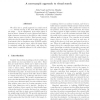Free Online Productivity Tools
i2Speak
i2Symbol
i2OCR
iTex2Img
iWeb2Print
iWeb2Shot
i2Type
iPdf2Split
iPdf2Merge
i2Bopomofo
i2Arabic
i2Style
i2Image
i2PDF
iLatex2Rtf
Sci2ools
CRV
2007
IEEE
2007
IEEE
A non-myopic approach to visual search
We show how a greedy approach to visual search — i.e., directly moving to the most likely location of the target — can be suboptimal, if the target object is hard to detect. Instead it is more efficient and leads to higher detection accuracy to first look for other related objects, that are easier to detect. These provide contextual priors for the target that make it easier to find. We demonstrate this in simulation using POMDP models, focussing on two special cases: where the target object is contained within the related object, and where the target object is spatially adjacent to the related object.
| Added | 02 Jun 2010 |
| Updated | 02 Jun 2010 |
| Type | Conference |
| Year | 2007 |
| Where | CRV |
| Authors | Julia Vogel, Kevin Murphy |
Comments (0)

